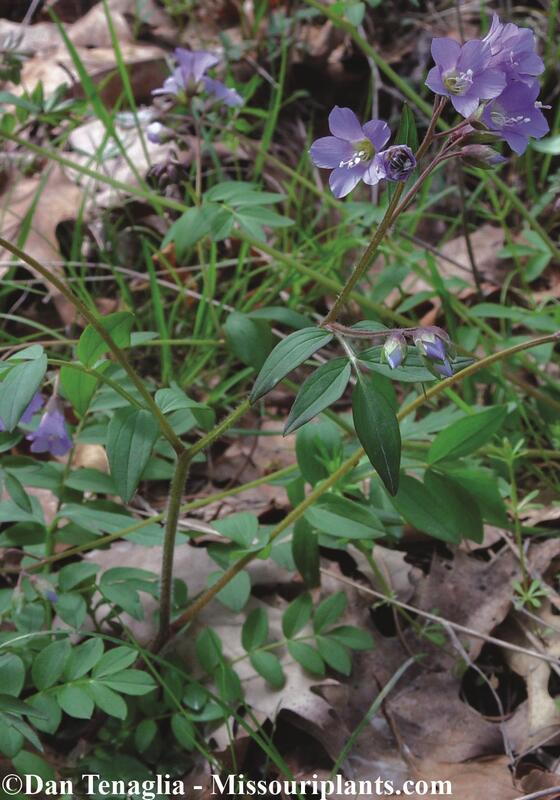






Polemonium reptans L.
Jacobs Ladder




Federal Protection: No US federal protection
State Protection: No Georgia state protection
Global Rank: G5
State Rank: S1S2
Element Locations Tracked in Biotics: Yes
SWAP 2015 Species of Greatest Conservation Need (SGCN): No
SWAP 2025 Species of Greatest Conservation Need (SGCN): No
2025 SGCN Priority Tier: None
Element Occurrences (EOs) in Georgia: 14
Habitat Summary for element in Georgia: Mesic hardwood forests over basic soils
Perennial herb forming small clumps of branched, hairy stems, 8 - 20 inches (20 - 50 cm) tall. Its leaves are up to 8 inches (20 cm) long, alternate, hairless, with a winged leaf stalk and 7 - 21 oval, opposite (occasionally alternate) leaflets that are 0.8 - 2.8 inches (2 - 7 cm) long; the lower surfaces of the leaflets are pale green, the upper surfaces are dark green with 3 conspicuous veins. Each flower cluster has a small, leaf-like bract on the stem just beneath the cluster. Flowers are 0.5 inch (1.3 cm) wide, blue-purple with greenish throats, bell-shaped, with 5 rounded lobes, 5 pointed sepals. A 3-lobed stigma extends slightly beyond the petals, and the stamens are shorter than the petals. The fruit is an oval capsule about 0.2 inch (6 mm) long, enclosed by the sepals.
Blue-flowered Phlox species (Phlox spp.) and Waterleaf species (Hydrophyllum spp.) have similar flowers, but the compound leaves of Jacob’s ladder with paired leaflets are distinctive.
None in Georgia.
Rich, low woods and bottomlands with soils high in calcium. Often occurs with Bladdernut (Staphylea trifolia), White Basswood (Tilia americana), and Oakleaf Hydrangea (Hydrangea quercifolia).
Jacob’s Ladder is a perennial herb that reproduces sexually by seed; it does not reproduce vegetatively. New shoots emerge from a semi-woody stem base in the fall, and these persist through the winter and spring. Flowering begins in early April, fruiting in late May, and germination in the summer or fall (i.e. its seeds do not require a period of cold in order to germinate). Its flowers are visited by a variety of insects and require cross-pollination in order to set fruit. Beetles and flies eat the pollen and butterflies and moths extract nectar. Bees are the major group of pollinators for Jacob's Ladder and are attracted to the nectar contained in the nectar chamber at the bottom of the flower (hidden beneath the hairs at the bases of the stamens); purple lines at the base of the flower act as nectar guides. On a given plant’s flowers, the anthers mature and produce pollen before the stigmas become receptive, preventing self-pollination.
Surveys are best conducted during flowering (early April–early May) and fruiting (late May–late June), but the compound leaflets with winged petioles are distinctive throughout the growing season.
Georgia, north to Maine, and west to Oklahoma and Ontario.
Logging, clearing, and development of habitat; damming streams; invasion by exotic pest plants.
Polemonium reptans is ranked S1S2 by the Georgia Department of Natural Resources, indicating that it is imperiled in Georgia. Eleven populations have been documented in Georgia, none on conservation land.
Georgia’s plants are among the southernmost populations of this species. Plants occurring at the periphery of a species’ range are thought to be of special conservation importance. Peripheral populations are usually smaller and less genetically diverse within the population, but genetically divergent from centrally located populations. These genetic differences may confer special survival traits that plants in other portions of the species’ range lack, such as the ability to survive changes in the climate or the arrival of a new pathogen. Peripheral populations may be in the process of evolving into a new species. They are especially deserving of conservation action.
Protect populations from logging, clearcutting, and residential and commercial development. Avoid damming streams. Eradicate exotic pest plants, especially Japanese Honeysuckle and Chinese Privet.
Baskin, J.M. and C.C. Baskin. 1992. Germination ecophysiology of the mesic deciduous forest herb Polemonium reptans var. reptans (Polemoniaceae). Plant Species Biology 7(2-3): 61-68. https://esj-journals.onlinelibrary.wiley.com/doi/abs/10.1111/j.1442-1984.1992.tb00219.x
Chafin, L.G. 2007. Field guide to the rare plants of Georgia. State Botanical Garden of Georgia and University of Georgia Press, Athens.
Davidson, J.F. 1950. The genus Polemonium (Tournefort) L. University of California Publications in Botany 23: 209-282.
GADNR. 2020. Element occurrence records for Polemonium reptans. Georgia Department of Natural Resources, Wildlife Resources Division, Social Circle, Georgia.
Gleason, H.A. and A. Cronquist. 1991. Manual of vascular plants of northeastern United States and adjacent Canada, 2nd edition. New York Botanical Garden, New York.
Grant, V. and K.A. Grant. 1966. Flower pollination in the Phlox family. Columbia University Press, New York.
Hilty, J. 2018. Jacob's Ladder, Polemonium reptans, Phlox family (Polemoniaceae). Illinois Wildflowers. https://www.illinoiswildflowers.info/woodland/plants/jacob_ladder.htm
Horn, D., T. Cathcart, T.E. Hemmerly, and D. Duhl. 2005. Wildflowers of Tennessee, the Ohio Valley, and the southern Appalachians. Lone Pine Publishing, Auburn, Washington.
NatureServe. 2019. Polemonium reptans comprehensive report. NatureServe Explorer. Arlington, Virginia. http://explorer.natureserve.org/servlet/NatureServe?searchName=Polemonium+reptans
Radford, A.E., H.E. Ahles, and C.R. Bell. 1968. Manual of the vascular flora of the Carolinas. University of North Carolina Press, Chapel Hill.
Tenaglia, D. 2006. Polemonium reptans species account. Missouri plants: photographs and descriptions of flowering and non-flowering plants of Missouri. http://www.missouriplants.com/Polemonium_reptans_page.html
Weakley, A.S. 2015. Flora of the southern and mid-Atlantic States. University of North Carolina Herbarium, University of North Carolina, Chapel Hill. http://www.herbarium.unc.edu/flora.htm
Wherry, E.T. 1942. The genus Polemonium in America. American Midland Naturalist 27(3): 741-760. https://www.jstor.org/stable/2420923?seq=1#metadata_info_tab_contents
Linda G. Chafin
L. Chafin, Jul. 2008: original account
K. Owers, Feb. 2010: added pictures
L. Chafin, Mar. 2020: updated original account.



